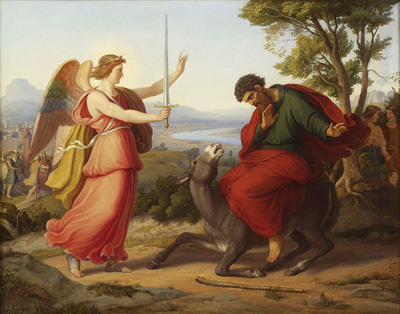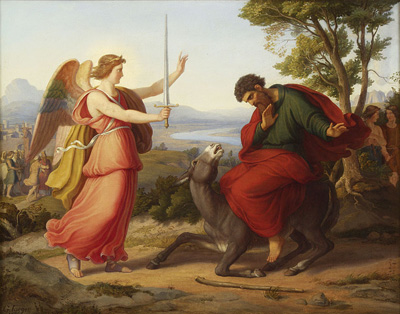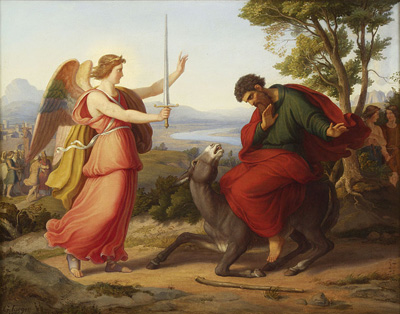
(RNS1-APR03) An 1836 painting by Gustav Jaeger Bileam portrays the prophet Balaam and his talking donkey, whom he beat after the donkey yielded to the angel in its path. For use with RNS-DONKEY-RESCUE, transmitted April 3, 2009. Religion News Service photo.

(RNS1-APR03) An 1836 painting by Gustav Jaeger Bileam portrays the prophet Balaam and his talking donkey, whom he beat after the donkey yielded to the angel in its path. For use with RNS-DONKEY-RESCUE, transmitted April 3, 2009. Religion News Service photo.

(RNS1-APR03) An 1836 painting by Gustav Jaeger Bileam portrays the prophet Balaam and his talking donkey, whom he beat after the donkey yielded to the angel in its path. For use with RNS-DONKEY-RESCUE, transmitted April 3, 2009. Religion News Service photo.
MOSHAV GAN YOSHIYYA, Israel — When Jesus traveled to Jerusalem, the New Testament says, he arrived on a donkey. And when Abraham, the biblical Patriarch of the Old Testament, prepared to sacrifice his son, Isaac, he first loaded up a donkey.
With such a storied lineage, you would think that donkeys in the Holy Land would garner the same kind of respect that cows enjoy in India, or reindeer receive in Lapland.
Yet donkeys in the Middle East, as elsewhere, are often saddled with far too much weight or abused outright by people who lack any appreciation for the mild-mannered animals.
Pained by reports of widespread donkey abuse in the Palestinian territories and, to a lesser degree, in Israel, British-born Lucy Fensom moved to Israel in 2000 to establish Safe Haven for Donkeys in the Holy Land (SHADH), a peaceful sanctuary for sick, abused and abandoned donkeys.
Fensom left her career as a flight attendant to create the sanctuary, which provides refuge to 114 donkeys, four horses and two mules. The family’s rented farm, which is part of a northern rural community just five minutes’ drive from the Israel/West Bank border, is also home to a menagerie of ducks, cats and a slew of guinea pigs.
The shelter is funded entirely by British and American donations, and the recent poor exchange rate has hit the organization hard, even as the landlord is asking for a 10 percent rent hike.
Fensom, who was raised in a Christian home, first traveled to the Jewish state 19 years ago and was immediately enchanted. Yet she was shocked when she saw young Jewish boys from a tough Jerusalem neighborhood mistreating the local cats, and she became determined to educate them.
“First I reached out to the girls in the neighborhood and slowly the boys took notice,” Fensom said, with a knowing grin. “I knew I’d made an impact when the boy who was the ringleader brought me an abandoned kitten, began caring for her, and ended up keeping her.”
Animal abuse isn’t unknown in the Bible, either. The Book of Numbers tells the story of the prophet Balaam, who beats his donkey after the animal is spooked by an angel in his path. “What have I done to you, that you have struck me these three times?” the back-talking donkey asks Balaam.
While modern-day abuse occurs in Israel, “it is much more widespread in Palestinian society,” Fensom acknowledges. “It’s a cultural thing…” where donkeys are often more available and less expensive than a tank of gasoline.
“It costs more money to treat a sick or injured donkey than to buy a new one, so they are usually left untreated and abandoned,” Fensom explains.
Both Palestinian and Israeli extremists have abused donkeys to express their political hatred, said Adi Zahor, Fensom’s husband and co-director of the sanctuary.
“I’ve seen footage of donkeys in Palestinian areas draped with Israeli flags that were whipped, beaten and kicked as they were led down the street. I once saw a photo of three or four grown men, Israeli right-wingers, who kicked a donkey who had been dressed as Yasser Arafat.”
Regardless of where the violence occurs, the results can be devastating, says Mohammed Mussawah, the shelter’s outreach field director.
“This is Burnie,” Mussawah says gently, walking up to a little brown donkey whose torso is still healing from a bad burn in September 2007. “A boy from a village in the West Bank found him in his field and poured some lighter fluid on him and lit a match to make him leave.”
Fensom’s eyes grow moist when she recalls Burnie’s arrival.
“He was all charred and when the vet removed the burned, crispy skin it was as if he’d been skinned. He can’t go out in the sun unless he’s covered up and we have to restrain him until he’s healed completely so he won’t scratch off the new skin,” Fensom says, pointing to a device that keeps Burnie upright but immobilized.
Around the corner, in a larger pen, Fensom introduces Murphy, whose eye was poked out with an electrical cable in a Palestinian village; Barnie, who is at the shelter not because he was abused, but because he is partially blind; and Toffee, who was just rescued from the Israeli town of Or Yehuda.
(BEGIN OPTIONAL TRIM)
“A man happened to be in the town for an interview and saw a group of boys hurting a tiny donkey. They had beaten him extensively and tied him to a tree with no food or water. This man paid the boys 300 shekels (about $70) to relinquish him,” Fensom said.
The animal activist emphasizes that the man, not the organization, paid the boys. “We never want to send the message that we’ll give you money for abusing an animal,” she said.
(END OPTIONAL TRIM)
Every year, hundreds of Jewish and Arab Israeli schoolchildren visit the farm, where they pet and groom the animals. Free of the carts and heavy loads they once bore, the donkeys can be seen for who they are, Fensom says: “incredibly docile and sweet.”
The shelter also operates a mobile clinic for working donkeys, horses and mules in the West Bank, where the majority of Holy Land donkeys live, and runs an education program for Palestinian children, who cannot enter Israel without a permit that is nearly impossible to procure.
Petting Teddy, whose left hind leg was badly injured by a Rottweiller in Tel Aviv, Fensom admits that educating the public hasn’t been easy.
“If you take a classroom of 20 students, maybe three or four children will internalize the message,” she said. “It does make me wonder sometimes whether the results are worth the effort, but I am determined to soldier on.”




